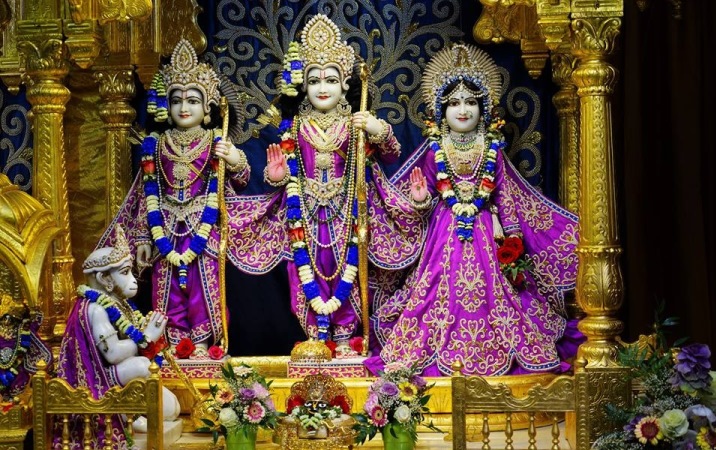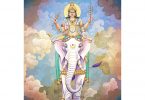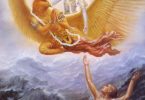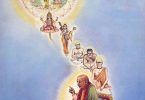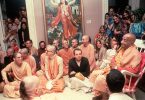Question: Part 1: Regarding Ravana’s touching/kidnapping Mother Sita, Srila Prabhupada often explains that Ravana could not really capture Sita, but maya-Sita (also in Lord Caitanya’s discussion with Ramadasa Vipra in Cc. Madhya 9.178-212). It also appears from the description in Caitanya-Caritamrta that this was only known to Mother Sita or perhaps only to Her and Lord Rama.
If it was maya-Sita who was kidnapped, and maya-Sita was a different person from the real Mother Sita, how do we understand the pastimes in the rest of the Ramayana? It seems to make Lord Rama’s feelings of separation and His tremendous efforts to get Her back appear like theatrical acting. It also seems to make the feelings of separation and devotion of Mother Sita in Lanka as somewhat inapplicable.
For example, Lord Krishna’s becoming afraid of Mother Yasoda is described by Queen Kunti as very difficult to understand because fear personified is afraid of Him and Lord Krishna is not just acting – Lord Krishna is really afraid.
Is Lord Rama keeping up an act even though He “knows” that the real Sitadevi was not kidnapped? In one sense, all lila of the Supreme Lord could be called acting for the pleasure of His devotees, given that ultimately Lord Krishna or Lord Rama knows everything.
Answer by Romapada Swami:
The pastimes of the Supreme Lord are enacted under the influence of yoga-maya or the internal potency of the Lord. Although Lord Krishna or Rama is omniscient, under the influence of yoga-maya He “becomes forgetful”, or so-called “makes mistakes” or is apparently ignorant of real facts. He is not simply putting an act “as if” afraid of Mother Yasoda, or “as if” overwhelmed by lamentation at losing Sita. He is actually experiencing the mood of a dependent child or a lover who has lost his beloved.
Sometimes being absorbed in thoughts of Srimati Radharani, Krishna tries to milk a bull! He is not pretending, but actually makes such mistakes under the influence of yoga-maya. This does not however interfere with His capacity for omniscience. Yoga-maya is His own energy, always subservient to Him, but He voluntarily comes under her influence in order to enjoy His pastimes.
As far as Sita is concerned, the fact that it was only an illusory form that Ravana seized and brought to Lanka does not interfere with the profound feelings of separation felt by Mother Sita. She was actually experiencing the ecstasy of love in separation, and Her shadow replica, maya-Sita, was also exhibiting similar feelings in Lanka.
Quite apart from the unfolding of events that led to Ravana’s destruction and establishment of the victory of virtue over evil, on another dimension this entire pastime was orchestrated to enhance the intensity of love in separation between Rama and Sita, much like the unfolding of events that led to Krishna leaving Vrindavana.
Part 2: How can Sitadevi be considered polluted/pollutable (e.g. by Ramadasa Vipra) by the touch of Ravana, which was very much against Her will, and even though Sitadevi is eternally pure as Maha-Laksmi? According to the Vedic system, is an ordinary woman considered materially polluted by the society by the mere touch or minor molestation by another person against her will? She may consider herself polluted, but does the society also consider her polluted? Of course, if she willingly touches or gets touched by another person in any way, she is definitely polluted.
Lord Rama consistently said that He knew Sitadevi to be pure. Yet, as an ideal ruler, He was concerned about the common public opinion, and so He asked her to take a fire-bath and even sent her to the forest.
Answer by Romapada Swami:
In the Vedic culture, great importance was attached to the purity and chastity of women, and as much importance was given to protecting them also. Srila Prabhupada remarked that if a lady happened to stay away from home even for the duration of one night without being accompanied by her father or husband, her character would come under question, and it was socially quite unacceptable. Essentially, such strictures and restrictions were placed in order to protect women from undesirable situations or abuse, and it was equally the responsibility of her guardians to offer her such protection. It was for this reason that Rama reproached Himself for allowing Sita to be left unprotected.
Although this is the normal standard, there are exceptions to be found. Lord Krishna Himself accepted and married the 16000 princesses who were kidnapped by Bhaumasura; although socially they might have been considered impure and thus no one would have married them, they were fully purified by virtue of their devotion. Draupadi was subjected to unthinkable harassment by the Kauravas, but was protected by Lord Krishna Himself and later avenged by her husbands, and certainly there was no question in anyone’s mind about her purity. There is also the story of Ahalya who was deceived by Indra and was cursed by her husband to become a stone, but was later purified from all contamination by coming in touch with Lord Rama and reunited with her husband, and other such examples.
As far as mother Sita is concerned, she was definitely beyond reproach. Lord Rama’s subjecting her to the test of fire, as you have already stated, was to establish the strength of her purity for the common public, which He did in the role of an ideal king. And Ramadasa Vipra’s anguish was not about whether Sita was considered to be polluted but about the fact that she was touched by the evil Ravana against her will.

